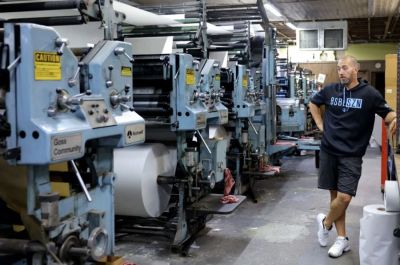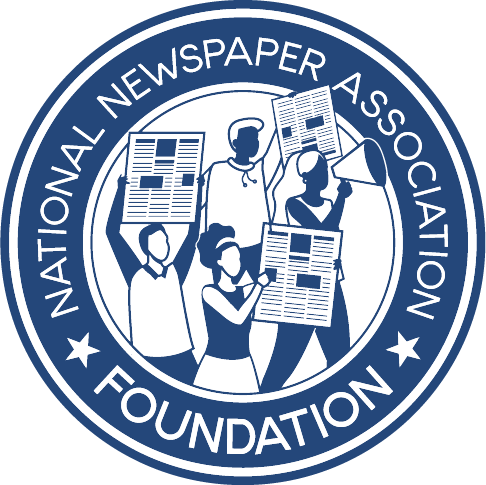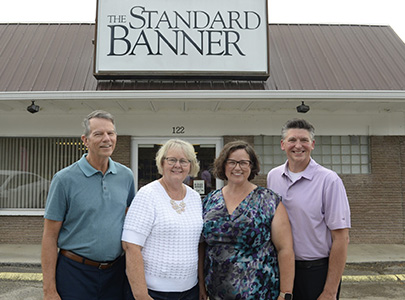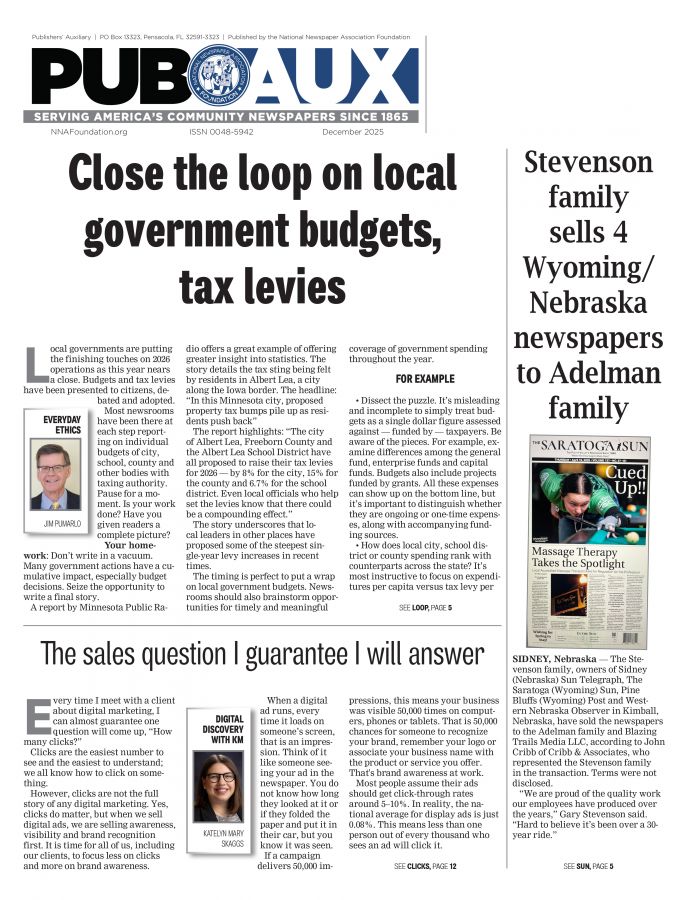Saving the Press: Publishers rescue Wyoming newspapers from shutting down to keep the heart and soul of their communities strong
Teri Saylor
Special to Publishers' Auxiliary
Oct 1, 2025

Days after eight small Wyoming towns were rescued from the brink of losing their weekly newspapers, a reader contacted the new owners with a simple request.
She asked for an easier crossword puzzle.
This resonated with Jen Sieve-Hicks, who, along with her husband, Robb Hicks, and colleague, Rob Mortimore, bought eight weeklies in Wyoming and one in Nebraska that almost went out of business when their corporate owner could no longer afford to publish them.
“It’s heartening to know that people are invested enough in the newspaper to reach out to us like this,” she said. “I have to believe that a request for an easier crossword puzzle comes from people who feel like that is their newspaper.”
For Sieve-Hicks, it was an easy fix.
“I made one phone call to switch the puzzles out, and the next week, there was an easier crossword puzzle,” she says.
Sometimes it’s the little things.
The nine newspapers the Hickses and Mortimore bought were among about two dozen community newspapers across five states that closed when News Media Corporation ceased operations on August 6.
The Hickses, who have owned and operated the Buffalo (Wyoming) Bulletin since 1996, have multi-generational ties to Wyoming newspapers going back seven decades. They also own other newspapers in Wyoming and in Colorado, Montana and South Dakota.
Sieve-Hicks and her husband are both past presidents of the Wyoming Newspaper Association and feel close to the communities the former News Media newspapers served. When they were shuttered, her heart broke for their readers as much as it did for the staff who lost their jobs.
For one thing, the newspapers closed on the eve of a new school year.
“My immediate reaction was, ‘oh my gosh, school is going to start in a couple of weeks and there is not going to be a record of that for those communities,’” Sieve-Hicks said.
She worried there would not be any front pages with first-day-of-school-stories or stories about first home football games.
“Those things might seem trivial to some folks, but when you are in a small Wyoming town and the next nearest town is more than half an hour away, what happens in your community matters to you,” she said. “And if the newspaper isn’t documenting it, nobody is going to.”
PUBLIC NOTICES WERE AT RISK
Of particular concern to the impacted communities was losing their government watchdogs. Publishers and local officials worried over what to do about the public notices that were required to run in those newspapers every week.
“Our government was in shock wondering where all those communities were going to place their public notices,” Mortimore said.
Wyoming statutes call for legal notices to be placed in a newspaper that has been regularly published for 52 consecutive weeks prior to the date of the first published notice. A newspaper is qualified to run public notices if its paid circulation is at least 500 and each page is at least 10 x 12.5 inches in size.
In addition to publishing properly, public notices must be filed correctly, Hicks said.
“After we publish the notices, we have to file affidavits, under penalty of perjury, that they did indeed run,” he explained. “We then have to clip those notices and send them, along with the affidavit, to the entities that placed them.”
Further, newspapers are required to maintain a permanent physical record of the notice on site, and a digital record must be available. The Wyoming Press Association maintains an online repository to help fulfill that requirement. Public notices are also filed at both the county and state libraries, Hicks said.
Public notice advertising has long been in peril, and the newspaper closures might have been devastating. Mortimore, who was News Media’s Wyoming group publisher before buying the newspapers, scrambled to find a way to avoid missing a week of publishing.
With News Media’s cooperation and approval, he managed to publish newspapers the week after the closures so they could continue to serve as their counties’ newspapers of record. Employees who had just lost their jobs stepped up to help publish them without any guarantees of being paid.
“We have an incredible staff across the state that volunteered their time to put those papers together and get them out,” Hicks said.
Meanwhile, behind the scenes, the Hickses and Mortimore were negotiating with News Media to buy those newspapers.
COMMITTED TO SAVING THE NEWSPAPERS
Mortimore grew up in Torrington, Wyoming, and he started his newspaper career at the Torrington Telegram. He worked his way up the News Media Corporation ladder to general manager and eventually became the group publisher of the newspapers he now owns with the Hickses.
Hicks is a third-generation newspaperman whose grandfather bought the Buffalo Bulletin in 1964 and kept it in the family. He acquired it from his father in 1996. Buffalo is his home base.
Jen Sieve-Hicks was teaching English at Montana State University in Billings when she met her husband, Robb. They married, and she moved to Buffalo and started covering the news after a staff reporter resigned.
“I had never written for a newspaper, not even a school newspaper,” she said. “When our kids came along, I transitioned into a copy editor role.”
Today, she is the Bulletin’s editor.
The Bulletin is a typical rural weekly newspaper with a circulation of 3,486 covering local government, high school sports, commerce and the county’s main economic drivers, primarily ranching, tourism and energy development.
“Reporting on natural resources makes up a good deal of what we do at the paper because we have a lot of federal lands,” Sieve-Hicks said. “The Bighorn National Forest covers about one million acres and bumps up against the town of Buffalo.”
When News Media Corp shut down, Hicks and his wife believed so fervently that buying the newspapers was the right thing to do that they took a big risk.
“I had so much confidence that we could not only save these newspapers but breathe life back into them that I borrowed against the Bulletin,” Hicks said.
Mortimore also secured a note using his house as collateral, and together they cobbled together a down payment and made an offer on all nine newspapers on August 8, two days after they were shut down. In a lightning-fast transaction, the sale was completed a week later.
In Wyoming, the press is a small but mighty family of newspapers. All 40 of them belong to the Wyoming Newspaper Association and are known for producing quality journalism.
NEWSPAPERS VITAL TO REMOTE COMMUNITIES
The Wyoming newspapers that were briefly closed represent a fifth of all the newspapers in the state. Their combined circulation is 9,230 (including the newspaper in Nebraska). Saving the newspapers also saved 29 jobs.
According to the U.S. Census, Wyoming is the ninth largest state in the U.S. in terms of land mass. But with a 2020 recorded population of 581,348, it’s the least populated. Cheyenne is Wyoming’s capital and largest city with over 65,700 residents.
Across the vast state, newspapers are vital sources of information in the small communities they serve.
In Buffalo, newspaper readership is robust with about 85% of local households subscribing to the Bulletin, Sieve-Hicks says. Outside of social media, competition is sparse with no other newspapers or local radio. The closest television station is in Casper, 110 miles away.
“Buffalo would be a news desert if it were not for the Bulletin,” she said.
Despite readership that is at an all-time high and little competition, selling advertising is tough.
“Some businesses and events shut down during COVID and have not come back, and that hurt advertising,” Sieve-Hicks said. “While the businesses we have in town are still loyal, the landscape has changed a lot, and it's not just Amazon.”
She cites changing consumer purchasing habits and their use of social media among the advertising challenges small newspapers are facing.
The idea of managing nine more newspapers has been daunting for the Hickses, but they have Mortimore, who has spent much of his career with those newspapers to lean on.
“I couldn’t have done this without Rob,” Hicks said. “He's has been working with these communities and knows them, and he knows what the revenue picture looks like and can accurately portray it.”
A COMMITMENT TO READERS
While the new owners admit they are still in a state of shock over what recently transpired, they have been touring the communities they serve to answer questions from readers and put them at ease. They are encouraged by the feedback they’ve received so far — including the request for an easier crossword puzzle.
In an interview just three weeks after buying the newspapers, Mortimore said the transition has been smooth, and he credits News Media Corps owner and CEO JJ Tompkins.
“I think for the most part everything is back to business as usual in terms of our day-to-day operations,” he said. “We've initiated some new business procedures, which have been enlightening and good for our employees, and they’ve been excited about the change.”
He doesn’t blame his former employer for the headwinds that led to shutting down the newspapers and credits him with making the ownership transaction as smooth as possible, including ensuring the staff received their final paychecks under News Media Corp ownership.
“Paying the employees was important to him,” Mortimore said.
In a recent column, Mortimore wrote: “These publications are not just businesses. They are the record-keepers of our lives, the watchdogs of our government and the gathering places where communities see themselves reflected. To imagine our counties without them was unthinkable.”
And to the readers: “Your passion affirmed what I have always known — a local paper is the lifeblood of a community. But that lifeblood depends on the community’s support. If you value your local paper, I ask you to invest in it, to read it and to stand with it in the months and years ahead.”
Teri Saylor is a freelance writer in Raleigh, North Carolina. Contact her at terisaylor@hotmail.com.









